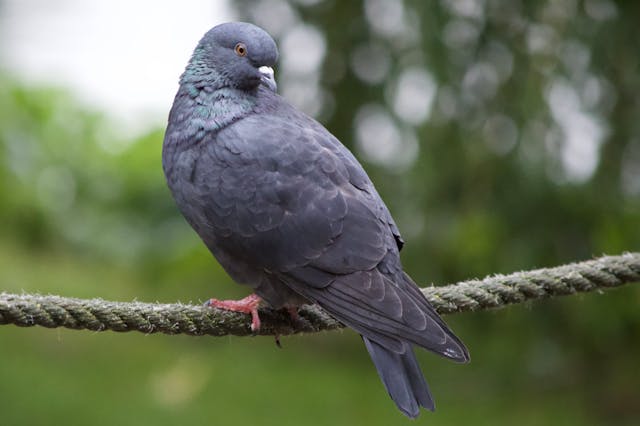
How do birds balance on a phone line? Birds can balance on a phone line because of the way their feet and legs work, their size, their vestibular system, and their balance organs. Birds can perch on pretty much anything without any trouble. In fact, they can also sleep perched on things like power lines that we would have trouble walking on, even with our eyes open.
There is another part to this question that is not about balance. Birds are able to perch on power lines and they never get electrocuted. This is because birds only touch one of the wires. If we were up there, we are much larger and we would probably touch two wires, getting electrocuted. When the current flows through the wire, it has an electrical potential. The flowing electrons will carry on along the wire unless an easier path is presented to them. When a bird is perched on a single power line, its feet have the same electrical potential as the electrons in the line, and the current doesn’t flow through them. If they were to touch the other line, as we probably would, the current has a new path to flow through, and that is how people get electrocuted. Larger birds are more likely to get electrocuted than smaller birds because their wings could touch the other cable.
So, how do birds perch on telephone lines? The first thing that allows them to do this is the way their feet grip. Birds have curled feet, which are the perfect shape for gripping onto round shapes. They also have a claw at the end of each toe, which grips. The secret to their balance, though, is a tendon-locking mechanism. When birds land on a perch and put their weight on their legs, the tendons in their legs and feet snap shut, holding their toes around the perch and keeping their legs stiff. This is all done without muscles, so they don’t have to expend any energy to perch. When they want to release, they use their muscles to unlock the tendons, and they can fly off. This is why birds’ feet are not great for picking things up. It is also how flamingoes can sleep standing on one leg.
The second reason birds can balance like this is their size. They are very small and very light, which means the telephone line they are balanced on won’t move that much. Humans have so much trouble walking on a tightrope or a slackline because our weight makes the line move a lot. Birds don’t have this. They are also naturally streamlined, and they can face so that the wind goes past them, rather than unbalances them.
The third reason is their vestibular system. This is made of the three tiny canals in the inner ear that go in all three axis and act like a gyroscope. They send signals to the birds’ brains about its position and allows them to make small movements to keep balanced. The signals go down from the brain to the spin,e and the bird shifts its muscles in tiny increments. These movements are called vestibulospinal reflexes.
The fourth reason they can balance is because of an organ called a lumbosacral organ, which is found in their tail and is a modified part of their spines. The spine in this area is fused, and there are lumps of tissue that are on either side of the spine and stretch over the top of it. The tissue is full of fluid filled canals, and it has a lot of mechanosensory neurons. When the birds move, the fluid in the canals moves around and comes into contact with the sensor neurons, giving the bird information about its movement. This has been tested by removing the organ from some birds. If the birds can see, they can balance with no problem, but if they are blindfolded so they cannot see (as they would be when asleep), the birds have a lot of trouble balancing. Meanwhile, birds that still have the organ can balance with no problem when they are blindfolded. This is an amazing organ, and it shows why birds have no trouble sleeping on a phone line when their eyes are shut.
Birds can balance and sleep pretty much anywhere, but roosting on phone lines is actually not that common. Birds would much rather sleep in the safety of tree foliage, or a nest hidden away inside a building or a cliff, than they would out in the open where they would be an easy feast for any local predators. And this is what I learned today.
Sources
https://birdfact.com/articles/why-do-birds-sit-on-power-lines
https://alum.mit.edu/slice/how-do-birds-sit-power-lines-without-getting-electrocuted
https://www.kohab.nz/kohablife/how-bird-feet-work
Photo by Marian Havenga: https://www.pexels.com/photo/pigeon-on-a-rope-19521543/
